|
|
|
Sort Order |
|
|
|
Items / Page
|
|
|
|
|
|
|
| Srl | Item |
| 1 |
ID:
153622
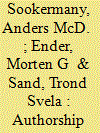

|
|
|
|
|
| Summary/Abstract |
Armed Forces & Society (AF&S) was founded in 1974 with the overall intention of creating an international arena for interdisciplinary approaches to the study of the military institution and the intersection of armed forces and their society. The present study is both a follow-up and an update of Morten Enders’s article “Authorship and Affiliation in Armed Forces & Society” covering 1,139 articles in the 41 volumes published from 1974 until 2015. The scope has been to look for the evolving trends on Authorship and Affiliation (A&A) within AF&S so as to say something about what AF&S has become over these years, as a consequence of whom the authors are and where they come from. Our findings suggest a developmental narrative of A&A in AF&S of a continuously higher author–article ratio, an increased female authorship ratio, and a wider range of disciplines from more continents, countries, and institutions, plus a trend of increased cross-national coauthorship.
|
|
|
|
|
|
|
|
|
|
|
|
|
|
|
|
| 2 |
ID:
153626
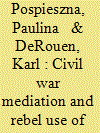

|
|
|
|
|
| Summary/Abstract |
Violence against civilians is portrayed as an antecedent of civil war, a cause, or both. Civil war creates opportune environments for planning and carrying out these acts that in turn can have detrimental effects on peace processes. Since not all civil war factions will see peace as beneficial, some actors may use violence to undermine the peace talks. The rebels may use indiscriminate violence to demonstrate their ability to exact costs on the government thus forcing the latter to negotiate. This article focuses upon acts of violence committed by rebel groups during mediated peace process. The central hypothesis is that violence against civilians increases the probability of mediation that in turn increases the prospects for violence. Using all civil war episodes from 1970 to 2008 as observations results from bivariate probit analysis endogenizing the choice of mediation bear out this theoretical argument.
|
|
|
|
|
|
|
|
|
|
|
|
|
|
|
|
| 3 |
ID:
153628
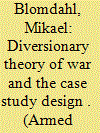

|
|
|
|
|
| Summary/Abstract |
This article examines President Clinton’s decisions to launch military actions against Iraq in June 1993 and Kosovo in 1999. This study represents an attempt to test the descriptive accuracy and further developing the diversionary theory of war. Using a qualitative framework for diversionary use of force developed by another researcher, Ryan C. Hendrickson, this research examines and compares the two cases in order to determine whether or not these strikes appear to be diversionary in nature. This article generally suggests that empirical support for the diversionary argument in these cases is “mixed” but has more validity in the actions against Iraq. Two proposals to further develop qualitative tests for diversionary use of force are advanced.
|
|
|
|
|
|
|
|
|
|
|
|
|
|
|
|
| 4 |
ID:
153625
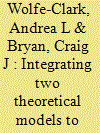

|
|
|
|
|
| Summary/Abstract |
Despite increasing prevention efforts, military suicide rates have surpassed those of the general population. This trend may reflect a deficit in our understanding of suicide, historically atheoretical and based on decreasing risk factors of suicide. The interpersonal–psychological theory of suicide (IPTS) provides a theoretical foundation to understand suicide but only assesses three risk factors of suicide and is primarily aimed at explaining who may die by suicide, but not when. The fluid vulnerability theory (FVT) provides a broad theoretical framework to understand and organize risk and protective factors of suicide in order to understand the process of suicide risk over time. Overlaying the IPTS’s constructs of thwarted belongingness, perceived burdensomeness, and the acquired capability for suicide within the FVT framework provides a robust model to understand not only who is at risk for suicide but also when suicide risk is likely to emerge.
|
|
|
|
|
|
|
|
|
|
|
|
|
|
|
|
| 5 |
ID:
153623
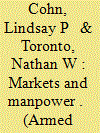

|
|
|
|
|
| Summary/Abstract |
Economic studies of military manpower systems emphasize the advantages of voluntarism under all but the most total threats, but this explains neither the persistence of institutionalized conscription in many states nor the timing of shifts from such conscription systems to volunteer militaries. Traditional explanations focus on external threat levels, but this has also proven unsatisfying. We theorize that threat variables establish the state’s baseline need for manpower, but structural economic variables determine whether the necessary manpower can be more efficiently obtained by conscription or voluntarism. Using a new data set of 99 countries over 40 years, we find that states with British origins are less likely and those experiencing greater external threat are more likely to employ conscripts. Most importantly, states with more highly regulated labor markets are more likely to employ conscripts, which suggests that, controlling for a number of relevant factors, labor markets matter in military manpower decisions.
|
|
|
|
|
|
|
|
|
|
|
|
|
|
|
|
| 6 |
ID:
153629


|
|
|
|
|
| Summary/Abstract |
This study investigates message strategies used in U.S. military commercials using Taylor’s six-segment strategy wheel. A content analysis of 125 military television commercials reveals that (1) majority of military commercials employed transformational strategy rather than informational strategy; (2) military commercials only used high involvement message strategies (i.e., ration, ego, and social) and no acute need, routine, and sensory commercials were observed; and (3) message strategies in military advertising varied across the number of wars and recruiting targets. Theoretical and practical implications of the findings are discussed.
|
|
|
|
|
|
|
|
|
|
|
|
|
|
|
|
| 7 |
ID:
153627


|
|
|
|
|
| Summary/Abstract |
Since the early 2000s, civil–military relations in Turkey have been tremendously overhauled. The National Security Council (MGK) lay at the crux of this transformation. This semi-military council was considered to be the principal formal channel that allowed the military to intervene in politics. Therefore, the reforms toward more civilian domination in the MGK were extensively hailed and reckoned as the end of the military’s protracted political role. However, subsequent developments did not verify this initial optimism about the demise of the old pattern of strong military presence in politics. This study examines the political activism of the reformed MGK. It suggests that the reforms trimmed the military’s power through subjecting its functions to civilian control. Nevertheless, this shift proved insufficient to end MGK’s political role. The MGK still actively takes part in politics and preserves its executive authority, although this authority is now performed concertedly by civilians and the soldiers.
|
|
|
|
|
|
|
|
|
|
|
|
|
|
|
|
| 8 |
ID:
153621
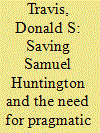

|
|
|
|
|
| Summary/Abstract |
How the U.S. military establishment interacts with other parts of the American government and the people impacts American national power. Because civil–military relationships are influenced by the context of the environment and the “kind of war” being waged, there are a variety of ways that military and civilian leaders can work together to improve the nation’s security. This article proposes an alternative civil–military relations model called pragmatic civilian control. It integrates Samuel Huntington’s objective civilian control theory with traditional American political philosophy and concepts established by Morris Janowitz, while accounting for current geopolitical conditions.
|
|
|
|
|
|
|
|
|
|
|
|
|
|
|
|
| 9 |
ID:
153624


|
|
|
|
|
| Summary/Abstract |
Cooperation in multinational military operations is one of the main tasks for the Swedish Armed Forces (SAF), which means that Swedish officers need to be able to meet international military staff standards. For this reason, the SAF and the Swedish Defence University organize an annual international staff exercise which aims to train officers in and increase their knowledge of North Atlantic Treaty Organization staff methods and procedures. The essence of successful staff work is good leadership and effective team work. In this article, we present findings from three staff exercises that have significant impact on leadership and possibilities for good team learning that relate to a team learning model. These findings have great potential to be of value in planning and improving leadership education and training in both military and civilian contexts.
|
|
|
|
|
|
|
|
|
|
|
|
|
|
|
|
|
|
|
|
|